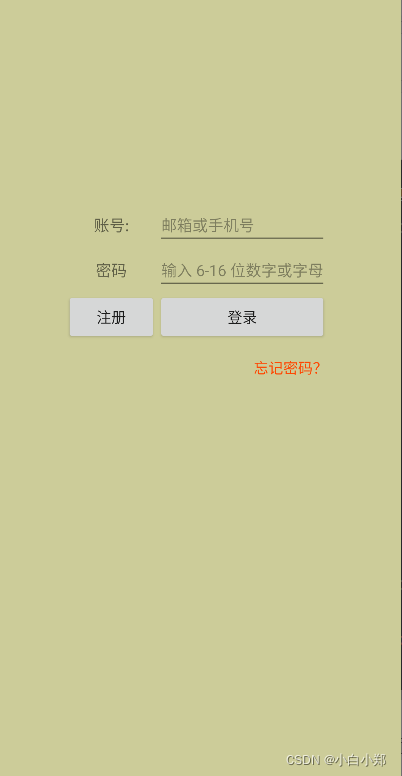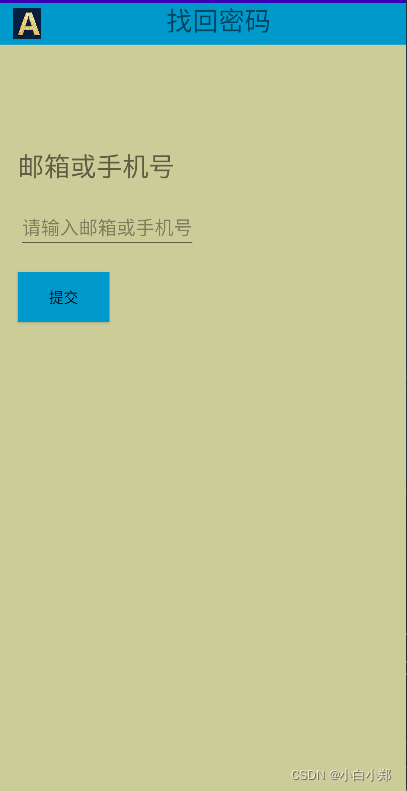Activity 概述
在 Android 应用中,提供了 4 大基本组件,分别是 Activity、Service、BroadcastReceiver 和 ContentProvider。而 Activity 是 Android 应用最常见的组件之一。Activity 的中文意思是活动。在 Android 中,Activity 代表手机或者平板电脑中的一屏,它提供了和用户交互的可视化界面。在一个 Activity 中,可以添加很多组件,这些组件负责具体的功能。
在一个 Android 应用中,可以有多个 Activity。这些 Activity 组成了 Activity 栈(Stack),当前活动的 Activity 位于栈顶,之前的 Activity 被压入下面,成为非活动 Activity,等待是否可能被恢复为活动状态。
启动 Activity 的两种情况
①、在一个 Android 应用中,只有一个 Activity 时,那么只需要在 AndroidManifest.xml 文件中对其进行备注,并且将其设置为程序的入口。这样,当运行时,将自动启动该 Activity。
②、在一个 Android 应用中,存在多个 Activity 时,需要应用 startActivity() 方法来启动需要的 Activity。
关闭 Activity
在 Android 中,如果想要关闭当前的 Activity,可以使用 Activity 类提供的 finish()方法。
举例说明:启动和关闭 Activity
核心代码如下
// MainActivity
public class MainActivity extends Activity {
@Override
protected void onCreate(Bundle savedInstanceState) {
super.onCreate(savedInstanceState);
setContentView(R.layout.activity_main);
getWindow().setFlags(WindowManager.LayoutParams.FLAG_FORCE_NOT_FULLSCREEN,
WindowManager.LayoutParams.FLAG_FORCE_NOT_FULLSCREEN);
TextView password = (TextView) findViewById(R.id.wang_mima);
password.setOnClickListener(new View.OnClickListener() {
@Override
public void onClick(View v) {
//创建 Intent 对象
Intent intent = new Intent(MainActivity.this,PasswordActivity.class);
//启动 PasswordActivity
startActivity(intent);
}
});
}
}
<?xml version="1.0" encoding="utf-8"?>
<TableLayout xmlns:android="http://schemas.android.com/apk/res/android"
xmlns:app="http://schemas.android.com/apk/res-auto"
xmlns:tools="http://schemas.android.com/tools"
android:layout_width="match_parent"
android:layout_height="match_parent"
tools:context=".MainActivity"
android:background="#CCCC99"
android:stretchColumns="0,3">
<!-- 第一行 -->
<TableRow
android:layout_height="wrap_content"
android:layout_width="wrap_content"
android:paddingTop="200dp"
>
<TextView />
<TextView
android:text="账号:"
android:layout_width="wrap_content"
android:layout_height="wrap_content"
android:gravity="center_horizontal"
android:textSize="15dp"
/>
<EditText
android:layout_width="wrap_content"
android:layout_height="wrap_content"
android:textSize="15dp"
android:hint="邮箱或手机号"
/>
<TextView/>
</TableRow>
<!-- 第二行 -->
<TableRow
android:layout_height="wrap_content"
android:layout_width="wrap_content"
android:paddingTop="2dp">
<TextView />
<TextView
android:layout_height="wrap_content"
android:layout_width="wrap_content"
android:textSize="15dp"
android:text="密码"
android:gravity="center_horizontal"
/>
<EditText
android:layout_width="wrap_content"
android:layout_height="wrap_content"
android:hint="输入 6-16 位数字或字母"
android:textSize="15dp"
/>
<TextView/>
</TableRow>
<!-- 第三行 -->
<TableRow
android:layout_height="wrap_content"
android:layout_width="wrap_content">
<TextView/>
<Button
android:layout_height="wrap_content"
android:layout_width="wrap_content"
android:text="注册"
/>
<Button
android:layout_width="15dp"
android:layout_height="wrap_content"
android:text="登录"
/>
<TextView/>
</TableRow>
<!-- 第四行 -->
<TableRow
android:layout_height="wrap_content"
android:layout_width="wrap_content"
android:paddingTop="15dp"
>
<TextView />
<TextView />
<TextView
android:id="@ id/wang_mima"
android:text="忘记密码?"
android:textColor="#FF4500"
android:gravity="right"
/>
</TableRow>
</TableLayout>
所得 主界面

//创建新活动 PasswordActivity
package com.example.example61;
import androidx.appcompat.app.AppCompatActivity;
import android.app.Activity;
import android.os.Bundle;
import android.view.View;
import android.widget.ImageButton;
public class PasswordActivity extends Activity {
@Override
protected void onCreate(Bundle savedInstanceState) {
super.onCreate(savedInstanceState);
setContentView(R.layout.activity_password);
//获得布局文件中的关闭按钮
ImageButton close = (ImageButton) findViewById(R.id.close);
close.setOnClickListener(new View.OnClickListener(){
@Override
//关闭当前 Activity
public void onClick(View v) {
finish();
}
});
}
}
<?xml version="1.0" encoding="utf-8"?>
<RelativeLayout xmlns:android="http://schemas.android.com/apk/res/android"
xmlns:app="http://schemas.android.com/apk/res-auto"
xmlns:tools="http://schemas.android.com/tools"
android:layout_width="match_parent"
android:layout_height="match_parent"
tools:context=".PasswordActivity"
android:background="#CCCC99">
<ImageButton
android:id="@ id/close"
android:layout_width="60dp"
android:layout_height="40dp"
android:layout_alignParentLeft="true"
android:background="#0099CC"
android:padding="5dp"
android:scaleType="centerInside"
android:src="@drawable/a" />
<TextView
android:id="@ id/t1"
android:layout_width="350dp"
android:layout_height="40dp"
android:layout_alignBottom="@ id/close"
android:layout_alignParentRight="true"
android:background="#0099CC"
android:paddingHorizontal="120dp"
android:text="找回密码"
android:textSize="25dp" />
<TextView
android:id="@ id/textview"
android:layout_below="@ id/close"
android:layout_width="wrap_content"
android:layout_height="wrap_content"
android:layout_marginTop="100dp"
android:layout_marginLeft="20dp"
android:textSize="25dp"
android:text="邮箱或手机号"
/>
<EditText
android:id="@ id/edittext"
android:layout_width="wrap_content"
android:layout_height="wrap_content"
android:layout_below="@ id/textview"
android:layout_marginTop="20dp"
android:layout_marginLeft="20dp"
android:hint="请输入邮箱或手机号"/>
<Button
android:layout_width="wrap_content"
android:layout_height="wrap_content"
android:layout_below="@ id/edittext"
android:layout_marginLeft="20dp"
android:layout_marginTop="20dp"
android:background="#0099C"
android:text="提交" />
</RelativeLayout>
单击找回密码所得界面

总结
到此这篇关于Android中Activity组件实例介绍的文章就介绍到这了,更多相关Android Activity组件内容请搜索Devmax以前的文章或继续浏览下面的相关文章希望大家以后多多支持Devmax!